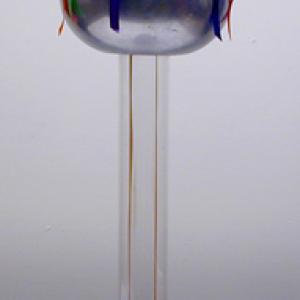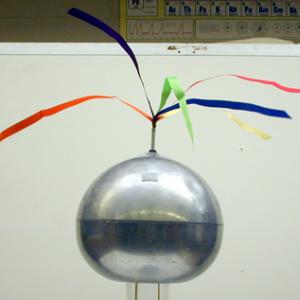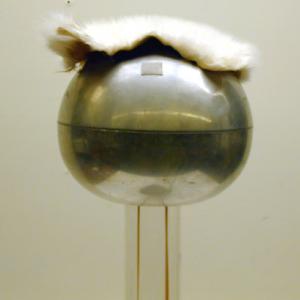College of Liberal Arts & Sciences
5B10.15 - Van de Graaff - Wig and Streamers
Attach the wig to the Van de Graff generator using the Velcro. The hairs of the wig should stand up and repel each other as charge builds up on the dome. The hair may be replaced by Kim wipes or the cloth streamers for the same effect.
A section of cat's fur may be set on top of the Van de Graff if a wig or streamer is unavailable. If not taped down the cat's fur will fly off the Van de Graff.
- George W. Ficken, Jr., "Weird Electrostatics Demonstration", AJP, Vol. 42, #2, Feb. 1974, p. 166.
- Ea-8, Ec-3: Freier and Anderson, A Demo Handbook for Physics.
- Robert A. Morse, "Laboratory Activity 5: The Electrostatic Hydra", Teaching about Electrostatics, p. 3 - 16.
- George M. Hopkins, "Frictional Electricity", Experimental Science, p. 363.
- Janice VanCleave, "Fly Away", 201 Awesome, Magical, Bizarre, & Incredible Experiments, p. 108.
- Rudolf F. Graf, "Making a Paper Spider", Safe and Simple Electrical Experiments, p. 24.
- Rudolf F. Graf, "An Electrostatic Palm Tree", Safe and Simple Electrical Experiments, p. 25.
- Joseph Frick, "# 257 - Experiments with the Electrical Machine - The Electrical Spider", Physical Technics: Or Practical Instructions for Making Experiments in Physics and the Construction of Physical Apparatus with the Most Limmited Means, p. 277.
- "The Head of Hair", Pike's Illustrated Catalogue of Scientific & Medical Instruments, 1984, p. 277.
Disclaimer: These demonstrations are provided only for illustrative use by persons affiliated with The University of Iowa and only under the direction of a trained instructor or physicist. The University of Iowa is not responsible for demonstrations performed by those using their own equipment or who choose to use this reference material for their own purpose. The demonstrations included here are within the public domain and can be found in materials contained in libraries, bookstores, and through electronic sources. Performing all or any portion of any of these demonstrations, with or without revisions not depicted here entails inherent risks. These risks include, without limitation, bodily injury (and possibly death), including risks to health that may be temporary or permanent and that may exacerbate a pre-existing medical condition; and property loss or damage. Anyone performing any part of these demonstrations, even with revisions, knowingly and voluntarily assumes all risks associated with them.


